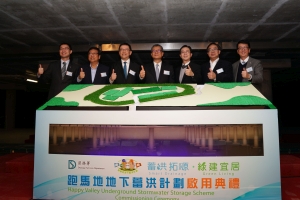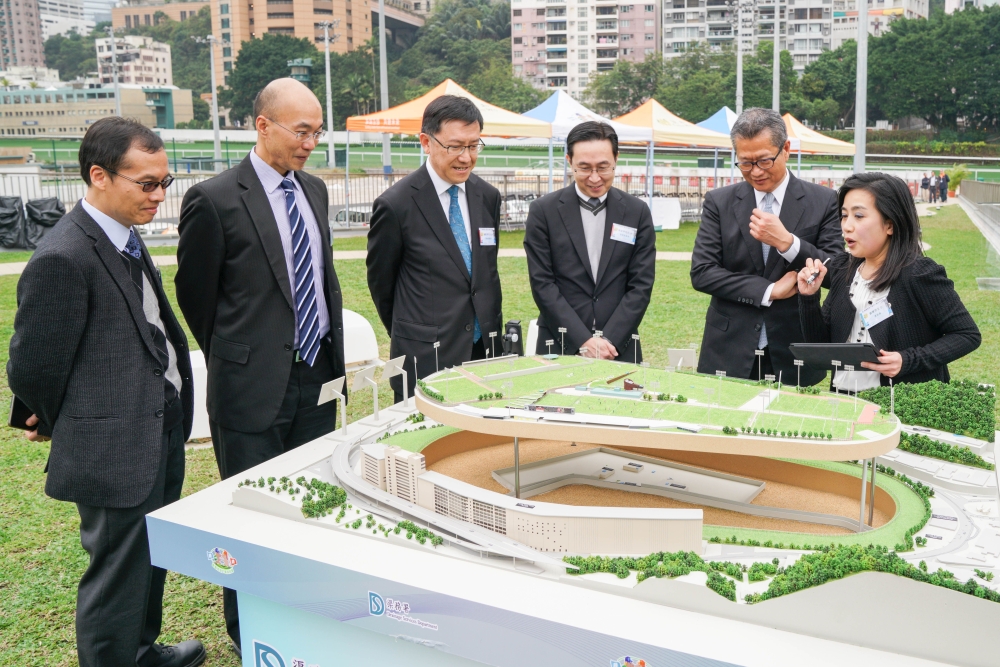Precautionary measures to prevent and control flooding




Precautionary measures to prevent and control flooding
In recent years, extreme weather has wreaked havoc across the globe and Hong Kong cannot remain unaffected. Taking last year as an example, the annual total rainfall in Hong Kong was 3,027 millimetres, which is the ninth highest on record. The rainfall recorded in January and October was 267 mm and 624 mm respectively. These figures were several times higher than the normal value of 24.7 mm and 100.9 mm and they hit the highest and second highest rainfall record for these two months respectively. The black rainstorm warning issued on October 19 last year was the first ever issued in October since the rainstorm warning system came into operation. In view of this, we must take precautions and prepare for the rainy season to safeguard the lives and property of the public.
With heavier rainfall, the rainstorm will come in a faster and more sudden manner. I strongly feel that the flood prevention infrastructures in Hong Kong are facing challenges from the extreme weather. I can remember that in the 1980s and 90s, extensive flooding often took place after rainstorms. Fortunately, serious regional flooding incidents rarely occurred in recent years because of the efforts made by various government departments, especially the effectiveness of flood prevention measures implemented by the Drainage Services Department’s (DSD) colleagues in various locations in the territory in the past two decades. Since its establishment in 1989, the DSD has completed about 90 major flood prevention works, including more than 100-kilometre river training works, four drainage tunnels in Hong Kong West, Lai Chi Kok, Tsuen Wan and Kai Tak, as well as three underground stormwater storage schemes located in Tai Hang Tung, Sheung Wan and Happy Valley. The major flood prevention works which are currently underway include Kai Tak River improvement works.
Early completion of Happy Valley Underground Stormwater Storage Scheme
I was delighted to attend the DSD’s Commissioning Ceremony of the Happy Valley Underground Stormwater Storage Scheme (HVUSSS) on March 16. During the ceremony, I watched an interesting and easy-to-understand video on the HVUSSS, which illustrated the operation, as well as the “smart drainage, green living” concepts of the storage tank. With the first-in-Hong Kong smart movable weir, real-time monitoring of the drainage system and the tidal level at the downstream outfall is performed at the storage tank, enabling in-time and effective temporary storage and drainage of stormwater. At the same time, underground water and stormwater are harvested at the storage tank for irrigation of the football pitches and toilet flushing. Around 220,000 cubic metres of water, equivalent to the capacity of 88 standard swimming pools, can be saved each year. Describing the storage tank metaphorically as “Sponge Kid”, the video explained how the HVUSSS managed to reduce stormwater runoff by means of flood storage, flood retention and rainwater harvesting under the “Following Nature, Adapting with Resilience” principles and “Sponge City” concept. The video is now available on the website of the HVUSSS: http://hvusss.eksx.com/video.php. I have been paying attention to the scheme all along, and understand that it had been progressing smoothly and completed one year ahead of schedule, because of the support and trust from stakeholders. I hope that this spirit of mutual trust and help can sustain and promote Hong Kong’s infrastructure development.
Planning ahead for future
Apart from carrying out flood prevention works, the DSD has been reviewing since 2008 the Drainage Master Plan Studies in various districts and devising relevant strategies in order to cope with challenges to the drainage system under rapid development and climate change. To date, we have completed the review studies for Yuen Long, North District, Happy Valley and Kowloon and proposed the corresponding improvement measures. Colleagues of the DSD will follow up proactively and strive to kick start the enhancement works as early as possible. Review studies for Sha Tin, Sai Kung, Tai Po, Northern Hong Kong Island as well as Lantau and outlying Islands are underway. Those for the remaining districts will also begin in a timely manner.
Reviewing standards to keep abreast of time
In face of the climate change, the Government set up an inter-departmental working group in June 2016, comprising members from various departments such as the Development Bureau, the Architectural Services Department, the Civil Engineering and Development Department, the Electrical and Mechanical Services Department, the Highways Department and the Water Supplies Department to evaluate the impact on the public infrastructures due to climate change and the Government’s strategies for addressing the risks. We have reached an initial consensus on the projections of rainfall and sea level rise. It is expected that these projections together with the unification of climate reference data will be completed by 2017, and related design standards for infrastructure can be updated accordingly. As for the projections and reference data for extreme climate, the working group is planning to conduct a consultancy study that is expected to complete in one to two years.
We will not take the challenges incurred by extreme climate lightly and will continue our efforts to undertake flood prevention measures. The rainy season is around the corner and the DSD will conduct inspections and tests regularly to ensure the proper functioning of its facilities. Also, the Emergency Control Centre will be activated during adverse weather conditions to coordinate the implementation of emergency flood relief measures. The public should also work together to ensure clearance of drainage channels and stay vigilant during inclement weather. With your help, I am confident that our flood prevention measures will be successful.
In recent years, extreme weather has wreaked havoc across the globe and Hong Kong cannot remain unaffected. Taking last year as an example, the annual total rainfall in Hong Kong was 3,027 millimetres, which is the ninth highest on record. The rainfall recorded in January and October was 267 mm and 624 mm respectively. These figures were several times higher than the normal value of 24.7 mm and 100.9 mm and they hit the highest and second highest rainfall record for these two months respectively. The black rainstorm warning issued on October 19 last year was the first ever issued in October since the rainstorm warning system came into operation. In view of this, we must take precautions and prepare for the rainy season to safeguard the lives and property of the public.
With heavier rainfall, the rainstorm will come in a faster and more sudden manner. I strongly feel that the flood prevention infrastructures in Hong Kong are facing challenges from the extreme weather. I can remember that in the 1980s and 90s, extensive flooding often took place after rainstorms. Fortunately, serious regional flooding incidents rarely occurred in recent years because of the efforts made by various government departments, especially the effectiveness of flood prevention measures implemented by the Drainage Services Department’s (DSD) colleagues in various locations in the territory in the past two decades. Since its establishment in 1989, the DSD has completed about 90 major flood prevention works, including more than 100-kilometre river training works, four drainage tunnels in Hong Kong West, Lai Chi Kok, Tsuen Wan and Kai Tak, as well as three underground stormwater storage schemes located in Tai Hang Tung, Sheung Wan and Happy Valley. The major flood prevention works which are currently underway include Kai Tak River improvement works.
Early completion of Happy Valley Underground Stormwater Storage Scheme
I was delighted to attend the DSD’s Commissioning Ceremony of the Happy Valley Underground Stormwater Storage Scheme (HVUSSS) on March 16. During the ceremony, I watched an interesting and easy-to-understand video on the HVUSSS, which illustrated the operation, as well as the “smart drainage, green living” concepts of the storage tank. With the first-in-Hong Kong smart movable weir, real-time monitoring of the drainage system and the tidal level at the downstream outfall is performed at the storage tank, enabling in-time and effective temporary storage and drainage of stormwater. At the same time, underground water and stormwater are harvested at the storage tank for irrigation of the football pitches and toilet flushing. Around 220,000 cubic metres of water, equivalent to the capacity of 88 standard swimming pools, can be saved each year. Describing the storage tank metaphorically as “Sponge Kid”, the video explained how the HVUSSS managed to reduce stormwater runoff by means of flood storage, flood retention and rainwater harvesting under the “Following Nature, Adapting with Resilience” principles and “Sponge City” concept. The video is now available on the website of the HVUSSS: http://hvusss.eksx.com/video.php. I have been paying attention to the scheme all along, and understand that it had been progressing smoothly and completed one year ahead of schedule, because of the support and trust from stakeholders. I hope that this spirit of mutual trust and help can sustain and promote Hong Kong’s infrastructure development.
Planning ahead for future
Apart from carrying out flood prevention works, the DSD has been reviewing since 2008 the Drainage Master Plan Studies in various districts and devising relevant strategies in order to cope with challenges to the drainage system under rapid development and climate change. To date, we have completed the review studies for Yuen Long, North District, Happy Valley and Kowloon and proposed the corresponding improvement measures. Colleagues of the DSD will follow up proactively and strive to kick start the enhancement works as early as possible. Review studies for Sha Tin, Sai Kung, Tai Po, Northern Hong Kong Island as well as Lantau and outlying Islands are underway. Those for the remaining districts will also begin in a timely manner.
Reviewing standards to keep abreast of time
In face of the climate change, the Government set up an inter-departmental working group in June 2016, comprising members from various departments such as the Development Bureau, the Architectural Services Department, the Civil Engineering and Development Department, the Electrical and Mechanical Services Department, the Highways Department and the Water Supplies Department to evaluate the impact on the public infrastructures due to climate change and the Government’s strategies for addressing the risks. We have reached an initial consensus on the projections of rainfall and sea level rise. It is expected that these projections together with the unification of climate reference data will be completed by 2017, and related design standards for infrastructure can be updated accordingly. As for the projections and reference data for extreme climate, the working group is planning to conduct a consultancy study that is expected to complete in one to two years.
We will not take the challenges incurred by extreme climate lightly and will continue our efforts to undertake flood prevention measures. The rainy season is around the corner and the DSD will conduct inspections and tests regularly to ensure the proper functioning of its facilities. Also, the Emergency Control Centre will be activated during adverse weather conditions to coordinate the implementation of emergency flood relief measures. The public should also work together to ensure clearance of drainage channels and stay vigilant during inclement weather. With your help, I am confident that our flood prevention measures will be successful.


